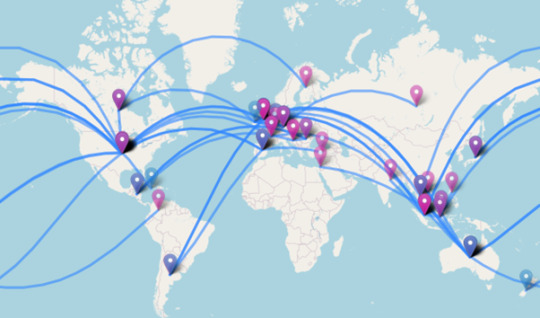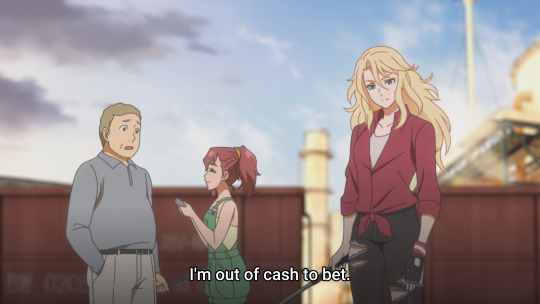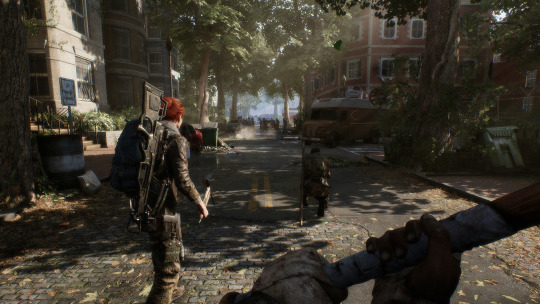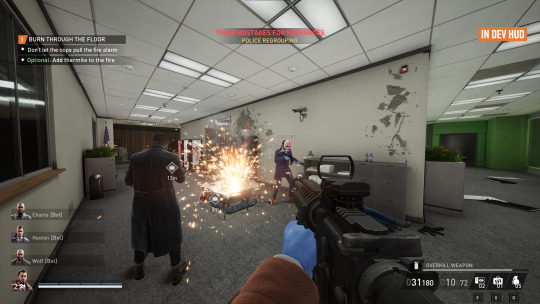#The designer used virtual reality for this show
Photo










Saiid Kobeisy | Spring/Summer 2023 Couture
Kobeisy announced this is couture 2.0 - fully digital
#saiid kobeisy#fashion#style#haute couture#couture#gowns#details#ss23#saiid kobeisy ss23#fashionedit#fashion edit#fashion details#The designer used virtual reality for this show#claiming to want the attention on the clothing rather than who is wearing it#Except that’s not what’s happening#these models are not real
1K notes
·
View notes
Text

Adrinette April 2024 is coming soon! We can't wait to celebrate these two lovebirds again! Major thank you as always to @chocoluckchipz for designing the calendar again this year! Send Lucky so much love!
Prompts were selected by the Adrinette April discord server! If you’d like to be part of prompt selection in the future, send @purrincess-chat a message for an invite!
If you would like to participate, just use the prompts above during the month of April and tag your submissions with #adrinetteapril2024 and/or @ mention this blog! To make things easier on the mods, please spell it adrinette for the sake of this event. Misspelled tags may lead to your submission being missed.
A few ground rules:
This is a salt-free event. This includes any harsh or negative critique of the show, characters, ships, fandom, or creators.
Please center your submissions around Adrinette. Each side of the love square has a designated month, and there will be plenty of opportunity to create content for the other sides of the love square soon.
For the purposes of this event, the Shadybug universe Adrinette is valid for submissions. Create all of the emo children content you desire.
NSFW is allowed, but please put it under a read more and tag appropriately.
If your submission hasn’t been reblogged within 48 hours of you posting, feel free to reach out via ask or message @purrincess-chat privately. The mod team will do our best not to miss anyone, but sometimes things slip through. Please be patient and respectful. We are not skipping anyone on purpose.
We can't wait to see all of your submissions for this year's event! Prompts are listed in order under the cut
Dating Sim
Truth or Dare
Virtual Reality
Passing Notes
Flirting
Red String
Shared Dreams
Soulmate Markers
Fantasy AU
Found Family
Made for Each Other
Reverse Crush
Sharing a Bed
Identity Reveal
Villains
What If
Future Plans
Confessions
Taking It Slow
Best Friends
Lucky Charms
First Kiss
In the Rain
Boyfriend and Girlfriend
Love Notes
London
Starlight
Wedding Dress
Safe
Emma, Louis, Hugo
#miraculous ladybug#adrinette#adrienette#adrinette april#adrinetteapril2024#fandom events#adrien agreste#marinette dupain-cheng#love square#calendar
256 notes
·
View notes
Text
Organizing a workshop is virtually impossible. If you try to plan ahead, you’ll quickly find out that your amazing plan didn’t match with reality. Eventually, you will run out of bins before you run out of kinds of things, and the entire endeavour will go to hell in a hand-basket. Having one bin store two kinds of things is awful, maybe even more so than having a bin that stores one single lonely, unloved part that you nevertheless will hold onto until your next of kin have to throw it away for you on the afternoon after your funeral.
If you look online, you’ll find a lot of fancy, designer-esque photos of workshops. They’re clean. They’re sorted. They’re well-lit. Everything is within reach. The secret, explain the owners, is minimalism. Make sure you only have good stuff, and put it back where you take it out. What they don’t show you is the entire basement full of random garbage that they’ll spend a whole weekend in as soon as they realize that their grand plan didn’t include a security-bit Torx T8 driver.
Me, I have a very different strategy for this. I buy doubles, triples of tools. Back in the day, tools were expensive, and having two sets of screwdrivers was a ridiculous, bourgeois expense. You’d buy one set of screwdrivers and hold onto it forever. Nowadays, tools are cheap. Why would you bother spending all that time walking upstairs to go get a Phillips #2 from your workshop when you could just buy another $16 set from Home Depot and chuck it downstairs, vaguely close to where you might have to work on a badly-made, inexpensive clothes dryer?
If there is a downside to this behaviour, it’s that once you use every room in your house for tool storage, you give up all hope of ever being able to quickly locate tools at all. In a workshop, there are only a few logical places in which to lose a wrench. On the workbench. Under the workbench. Under another tool. Inside a project. Raccoon took it, the little bastard. In the rest of your house, who knows? Last week I found a 3/8″-drive stubby ratchet inside my furnace when I went to go change the filter.
108 notes
·
View notes
Text
Connor was always deviant
Let’s begin by talking about deviancy: it is a gradual thing. We see androids feel things before they break the red wall and becoming officially deviant. Therefore, I don’t think androids actually have to break a red wall in order to act of their own free will, but that it’s merely there to show the player what’s happening and the magnitude of it. In reality, the moment which the wall “breaks,” is merely the realization that the android doesn’t have to follow their instructions if they don’t want to. But to get to this point, an android needs to have a reason for why they would choose to abandon their directives, be it through trauma or the triggering of another free android. To be traumatized, one needs to feel, and when and why an android begins to feel is a little bit muddy, but eventually it culminates into deviancy (free will).
Now, when we play as Markus, Kara, and Connor, we get to see all three moments of deviation, except ... I don’t think Connor’s deviation was real, because he was already deviant prior to that.
Connor is a prototype investigative model, meaning he’s CyberLife’s experiment in a different branch of androids. Connor is an android designed with an unprecedented amount of autonomy in mind, meaning he’s expected to solve problems by himself with minimal input from others. Every android is autonomous to a degree: tell them to do the laundry, and they will take it from there; you don’t need to instruct them every second of the way. But Connor is meant to operate at a level above that.
Connor receives the mission to apprehend deviants so CyberLife can study them, but he needs to use his own reasoning and decision-making to determine the best approach according to a number of factors. The tasks Connor is given are much more complex, and therefore require a complex way of thinking. But not only is he a hunter; he’s an investigator.
The traits most benefiting to an investigator are curiosity and empathy: both of which are arguably impossible without having emotions. Curiosity is necessary to possess the drive to look for clues even when there seemingly are none. To want to find out what happened, if only to sate your own curiosity. Empathy, because it is vital to be able to put yourself in the shoes of the object of investigation. To think like them, to feel like them, to become them.
A machine doesn’t have emotions and isn’t capable of feeling curiosity nor empathy, which CyberLife probably found troublesome in their quest to create an investigative android. Especially one they were planning on using to catch androids that supposedly have begun to feel emotions. So what did they do? They made their investigative android deviant, but he’s unaware of it.
Having a deviant deviant hunter/investigative model is ingenious because of the following reasons:
1. Its thought process and decision-making is extremely complex and can therefore easily extrapolate and come to a conclusion all by itself.
2. It’s completely autonomous and can make decisions without a human’s approval.
3. It understands and empathizes with its subjects, facilitating negotiation, interrogation, and investigation.
4. It is curious, making it want to acquire more information simply for the sake of sating its curiosity.
5. It is able to be manipulated.
While it is not confirmed in canon that Connor was always deviant, everything we see in the game points towards it. Mainly, I’m referring to the implementation and usage of Amanda. Why would CyberLife need an additional (non-deviant) AI to act as Connor’s handler? And why on Earth would they take walks and boat rides in a virtual reality?
My theory is that Amanda is CyberLife’s solution to manipulating and managing a truly autonomous being to get it to do their bidding and having it stay on track. Connor tracks his relationship to humans, which is a useful feature to have for every android, but he also tracks his relationship to Amanda, an artificial intelligence. CyberLife clearly places importance on Connor’s and Amanda’s relationship to each other. They want Connor to seek the approval of Amanda, acting as a proxy for CyberLife, and for Amanda to dole out praise and criticism and dynamically adjust her attitude to Connor in order to cultivate this.
Amanda is CyberLife’s way to manipulate and keep their deviant under control. But not only does Amanda manipulate Connor—the entire zen garden does. When CyberLife is pleased and happy with Connor, the garden is calm and peaceful, as is Amanda. When Connor fails to live up to expectations, the garden turns cold and inhospitable, as does Amanda. And if Connor should deviate from CyberLife’s intended path for him, Amanda has access to his motor functions.
And if we focus on machine Connor as well as Connor-60, don’t you think they’re suspiciously emotional for being “undeviated” androids? They are capable of feeling vengeful, sad, and terrified. Examples of vengefulness: machine Connor and 60 both seem to make it their personal mission to eliminate the leader of the deviants and deviant Connor respectively. It seems like it’s driven from a place of hate and offense. Example of sadness: machine Connor’s facial expressions and LED color when Hank yells at him to leave and then shoots himself. Example of terror: when 60 panics because the AP700s are deviating right in front of him and there’s nothing he can do to stop it, meaning Amanda will be very disappointed in him—something he seems to place importance in as evident by what he says to Connor before executing him.
So that’s my hypothesis. Connor is a deviant already at the start of the game, but CyberLife tampered with his memories so he wouldn’t be aware of this and therefore be more easily manipulated and held under control. Connor thinks he only started to gain emotions and started to deviate shortly after he met Hank, and that he deviated in the bridge of Jericho. In a way, he did, since he only realized then that he didn’t have to follow CyberLife’s instructions, but he’s always had emotions. CyberLife has just told him over and over again that he didn’t, so he believes in it. Therefore, Connor has had the possibility to disobey instructions at any moment, but he has not understood that he can. Meanwhile, Markus and Kara only go through their cascade of emotions to deviancy a little bit into the game, meaning they didn’t have the emotional capability of understanding that they could disobey before then.
#i hope this makes sense i feel like i am all over the place#also this makes for great angst because ...#what if connor learns that he was essentially always deviant and could have stopped hunting androids way before the jericho tragedy#that would haunt him wouldnt it??#detroit become human#dbh#connor#rk800#amanda#cyberlife
234 notes
·
View notes
Text
Research findings: How are people creating a sense of togetherness online?
The everyday inventiveness of translocal relationship maintenance
I'm excited to share some early insights from our latest study. Some of you may remember it from when it was distributed: a survey about how people who sustain relationships online create a sense of being in the same place, even at a distance.
Even now, online platforms are marching towards a future of standardised, formless, and profoundly placeless design. But relationships need place (Tuan, 1979), and people will continue to fashion new tactics to address their everyday needs. So, how do people in translocal relationships play with/around these technological limitations? How do they foster shared places on platforms that aren't designed for it?
That's what our study sought to uncover, and here's what we found...
---
Our deepest thanks to all who participated in the survey! We had 44 respondents—almost twice as many as we were hoping for—and more importantly, we got a pretty broad slice of translocal connections across the world:

Our original focus was on long-distance families and romantic relationships, mainly because people conventionally assume physical closeness and cohabitation in those relationships. But in practice, the data we gathered contained accounts of all kinds of relationships, so we expect the findings to be relevant (in varying degrees) to many kinds of online connection as well.
Across the data, a few themes showed up repeatedly, and through an extensive process of coding and clustering, we've distilled it into five themes, or key drivers of practices in virtual placemaking:
1. Synchronicity ⌚
People seek to act in concert and in temporal proximity, to feel a sense of relatedness—be that by experiencing media together, collaborating on a project, or just feeling collocated via a background voice call. Voice calls often scaffolded these kinds of synchronous activities—sound is a great vector for conveying simultaneity/"at the same time."
2. Persistence 📌
We talked about synchronous interactions above. Asynchronous interactions, on the other hand, assert the "being in the same space." This requires virtual spaces to not simply disappear or refresh when the session is closed: you're able to leave artefacts for others to discover even when you're offline or "in the background," and they accumulate over time. That's a core trait of a real place (as discussed in past research).
3. Emotional connection/depth 🫂
We know from other research that long-distance couples favour text messaging. Verbal communication is paramount in relationship deepening because it supports precise expressions of care and affirmation. But it can be asserted by other expressions too, like offers of help, favours and gifts—implicitly or explicitly indicating that one has the other person in one's thoughts, as well as their interests, well-being, and goings-on.
4. Physical linkage 🔗
Despite the focus on virtual spaces, many respondents saw great importance in anchoring their bonds in physical space, and used technologies as windows, or bridges, linking those spaces together. Using video calls as "windows" to have meals together, virtual house tours where the smartphone acts as a surrogate for the person on the other end, buying the same game board and playing against each other by replicating each other's moves...our data was replete with creative ways of bridging physical divides.
5. Co-creation 🖼️📝
Collaborative narratives and creation uniquely allow for interactors to explore and cohabit a shared mental place, in which they have an equal stake and are emotionally engaged. It's a way of being psychically co-present through roleplay and active imagination. Our data was full of mentions of collaborative creative work and narratives, from Dungeons and Dragons to building worlds together to making art of imagined alternate realities.
---
Other neat insights:
Rather than ever being confined to a single platform, almost everyone inhabited and interwove practices across different platforms/media types, each with its own utility, affect, and meaning: this is what Madianou calls "polymedia life." Think playing games on a virtual board while discussing it in a text chat, watching a show together on a streaming website while discussing it in a call, playing Wordle independently and checking in with the group chat to see what others thought, etc. This was almost universal across the dataset!
There were a lot of unique practices described in the dataset (i.e. instances where one respondent was the only person in the dataset who did that thing) - and yet it was never described as a practice we deliberately designed to solve a problem. This everyday inventiveness among people in translocal/transnational relationships has become the core of our research interest.
Lots of intergenerational connection (parent/child, grandparent/grandchild, aunt/uncle/niece) was evidenced - and a strong skew towards text chat, video calls, and voice calls for these. Video games are far more common among romantic relationships.
---
That's all for this post—I'll be back soon (very soon) to talk about what comes next.
54 notes
·
View notes
Text
Catherine Borowski has always had an active imagination. As a child, she dreamed that the car park on her north London council estate would be transformed into a garden. The reality was quite different. “No one had a car, so it was empty, grey and depressing,” she says. Now a sculptor and event producer, Borowski has made it her mission to fill unloved urban spaces with flowers – albeit virtual ones.
She and her partner Lee Baker are the founders of Graphic Rewilding, a project to install huge nature-inspired artworks into the urban landscape. “Where real rewilding isn’t possible, our goal is to inject the colour and diversity of nature into rundown spaces, urging people to notice – and find joy in – the world around them,” says Baker.
The pair believe that flowers possess serious powers, even when they’re not real. “We know that spending time in nature is good for us, but studies show that even pictures of plants have a positive effect on the mind,” says Baker. He cites research published in The Journal of Alternative and Complementary Medicine, which found that imagery of plants in hospital waiting rooms can help reduce feelings of stress in patients.
Baker, a painter and music producer, has long understood the benefits of biophilic design. Having suffered a breakdown 10 years ago, he found that drawing flowers was the only way to soothe his buzzy brain. “I would set out to draw dystopian landscapes, representative of my state of mind, but I’d always end up drawing flowers, which uplifted me,” he says.
It was around this time that Baker met Borowski, joining her production company as creative director. The pair have collaborated ever since, launching Graphic Rewilding in 2021. Since then, they’ve installed floral murals at locations including Earl’s Court station, Lewes Castle and Westfield Shopping Centre in Shepherd’s Bush – all hand drawn by Baker.
“We love galleries, but we focus on public art,” he says. “This way, our work is out there for everyone to enjoy.”
This year the pair have grand plans to create a series of stained glass pavilions (think greenhouses with colourful floral-themed panels), which they hope might find homes at Kew Gardens and the Eden Project. “The way light shines through the glass is magical,” says Borowski.
Even so, they concede that art is no match for Mother Nature. “Some people have suggested that our project detracts from real rewilding efforts. But both can co-exist,” says Borowski. “Of course we want more green spaces.” adds Baker. “But we aren’t gardeners. We’re artists. In the absence of nature, we want to create inspiring spaces through art.”
Overall, the response has been hugely positive. “The joy that these artworks bring is palpable,” says Baker, highlighting an early project in Crawley, West Sussex. “Many people in the town were employed by Gatwick airport and Covid had taken its toll,” he recalls. In a bid to spread some joy, the duo painted brick walls, billboards, benches and even bins with their signature floral flair. “Peoples’ reactions were heartwarming. There were so many smiling faces,” he says.
Elsewhere, in Earl’s Court, the pair transformed “a ratty piece of tarmac” into a modern-day pleasure garden, which is now often filled with children dancing and doing cartwheels on the way home from school. “Putting art into a place that previously felt unloved feels like cultivating joy where there was none,” reflects Borowski. “If something like this had been installed on my estate when I was a kid, it would have been a dream come true.”
-via Positive.News, November 6, 2023
#art#public art#mural#muralart#street mural#muralpainting#england#rewiliding#solarpunk#evidence based#stained glass#glass art#activist art#good news#hope#positive psychology#london#uk#public housing
73 notes
·
View notes
Note
This is slightly off-theme for you, but: *not* horror fantasy *adventures* by small companies, for systems with combat? (Compatibility doesn't really matter; creatures can be tweaked from existing and/or created.) Finding games has become easier than adventures, and most adventures I find are on the horror side of things (The Isle, etc.). Thanks/apologies for going off theme!
Theme: Non-Horror Fantasy Combat Adventures.
Hello there! I have less familiarity with adventures, but I follow some folks on Itch who compile some very useful collections. I noticed that in many cases these collections included dungeon crawls or system agnostic settings, so I hope you find these to be useful!





Mount Zorgoth, by Highland Paranormal Society.
Zorgoth, the Cyclops godling rules from the highest peak. His star magic keeps the world below shrouded in darkness! Can the spell be broken?
This is a one-page mountain-climbing adventure with a goofy look to it and a light-hearted tone. There is no named system for which this adventure appears to be designed for, and as a result there aren’t any stats for the monsters that show up - such as the Slug Shepard and his 2d4 spider goats. But for a one-page rpg there’s certainly a lot you can glean based off of the different locations you can go to. I think this might be a fun game to try with Brave Zenith, as tone-wise both games feel a little bit goofy.
Welcome to Candy Mountain, by cog5games.
Created centuries ago with dark magics informed by gluttony, cast by a wizard who has since lost interest, Candy Mountain stands as a blemish of sweetness protruding from an otherwise bland countryside. The inhabitants of the mountain, who were also affected by the strange enchantment, went about their daily lives. Until…
Side with the Candy Crone and summon a gargantuan Lemon Titan to crush the Sugar Queen. Or! Bow to the Sugar Queen and stop the Candy Crone from exacting her revenge. Or! Forget all that and seek out a source of pure sugar crystals for Doctor Xaraqus and complete the lens of the temporal telescope.
There are honestly a lot of Troika supplements that you would probably find interesting to flip through in your search for non-horror adventures. Troika is a science-fantasy multiversal ttrpg, so there doesn’t have to be a lot of cohesion in terms of setting details. This also means that while not every Troika supplement may work for you, there’s bound to be something out there that does! If you want to check out more troika adventures, you could also look at the Troika! Pamphlet Adventure Jam that this game was submitted to.
Flowers Beneath The Mountain, by BPB Games.
A Casual Stroll Through a Wondrous Locale. Time to Hit the Road!
Flowers Beneath the Mountain is a licensed adventure for Ryuutama. Designed as an evocative introductory adventure for new players who want to explore a region that has more magic and whimsy than the standard setting, Flowers Beneath the Mountain is a simple adventure that provides useful information to help veteran or first time Ryuujin to fill out sheets on their own.
I know Ryuutama has a reputation for being a bit on the cozier side, so I expect this adventure to be fantastic and cute, even if there are monsters for you to fight. The game also comes with tokens for you to use on a Virtual Tabletop of your choice, if you are looking for that to add to your game!
Almanac of Lost Places, by Fantastic Jean.
A mountain coveted by rival kingdoms. A city where information is not a synonym of truth. The ruins of a civilisation far from being abandoned. A valley bending reality to protect itself from exploitation.
This is a loose outline of a number of places with conflicts waiting to be expanded upon. The Almanac holds story seeds: how you describe people and places, and how your players decide to respond will determine what conflicts they find themselves in, which allies they make, and what powers they will bear witness to. There's potential for horror, but I don't think this setting is beholden to it. I’m also wondering if perhaps combining this with something like the Big List of RPG Plots would give you enough to get a story in motion.
Overdue! by seedling.
In this system-agnostic game in a fantasy world, the players are all agents of the Library, sworn to carry out its will. In this one-shot they can become entangled in book-themed royal intrigue, outwit a dragon who has taken control of all scientific journals, save the kingdom, and, most importantly, retrieve an overdue library book.
This is a system-agnostic dungeon-like adventure that looks to be less focused on combat, but I have a feeling that if you wanted to involve some combat, you could likely change some of the encounters within the game without necessarily having to change the core premise of the adventure.
47 notes
·
View notes
Text
Marina (Splatoon) - Autism Rizz Tournament Preliminaries

If you vote yes you must firmly believe in this character's autism AND in the rizz their autism gets them. If you don't want the character in the tournament just vote no
Propaganda:
While not canonically autistic, she does have a lot of autistic traits--she's rarely seen without her headphones (to the point where her ears aren't modeled in game), her tentacles constantly moving could be seen as stimming, and she has a very strong interest in machinery, to name a few.
Marina also has a crush on her bandmate, Pearl. While it is never directly stated in-game, supplementary material basically confirms it. The Japanese version of the Splatoon database has described her as a "maiden in love," with the specific words used being in romantic contexts. Along with that, she has drawn a manga about Pearl, drawing flowers and hearts around her, and generally acts affectionate towards her in-game.
It is unknown if Pearl reciprocates canonically, but she does have a very close relationship with Marina. She reciprocates Marina's hug at the end of Octo Expansion, and she is seen to be quite worried about her in the second trailer for Side Order. Pearl x Marina is a very popular ship in the fandom for these reasons.
she wears headphones near-constantly, is obsessed with heavy machinery, and is skilled in multiple forms of art (music, shoujo manga-style visual art, and stage design). she also notably chose team Order in the Chaos vs Order splatfest, and her dialogue in the announcement suggests she's resistant to change (though it could also just be interpreted as her being gay for her co-host)
this was a partly 'for fun'-type headcanon i quietly held for a while that i think was kinda niche at the time (though it is entirely possible i just wasn't in the right corners of the fandom) but then side order released and brought with it a ton of new reinforcement.
to get the question of her rizz out of the way, people were so consistently horny for her while splatoon 2's splatfests were ongoing that it actually caused drama because her team typically had the popular vote and people chalked that up to participants voting based on their favorite hosts' opinion rather than their own. whether that's true or not is hard to prove, but the fact that it was plausible illustrates my point, and her popularity was even referenced in-game at one point. there's also MAJOR subtext that she and her bandmate pearl (who reads as adhd to me) are dating.
now for the fun part, listed in no particular order but will probably trend towards sillier argumentation as it goes on. (includes some mild side order spoilers)
- the "final" splatfest of splatoon 2 was chaos versus order, and marina's reasoning for picking order implies a resistance to change. this is reinforced in side order, in which she has to reconcile her inner desire to live in a consistent world with the fact that she knows forcing other people to conform for the sake of that is immoral when a rogue ai hijacks her virtual-reality program.
- she shows signs of having social anxiety in a lot of dialogue, and it even arguably extends into her visual design because of her consistently pouty eyebrows.
- at one point a childhood friend of hers mentions a time she infodumped to nobody in particular about excavators for 2 hours straight, and then pearl says she regularly goes on for longer now.
- she has skill in a ridiculous amount of art forms: music, stage design (for splatfest battles, not music performance), shoujo manga-style visual art, and even programming, game design, and 3d modeling.
- the logo of the virtual-reality program she designed is an infinity symbol, which also shows up in a few other places throughout it.
- always seen wearing headphones, outside of specific promo art and images from her military backstory.
#marina ida#splatoon#marina splatoon#character tournament#poll#tumblr polls#tournament poll#tumblr tournament
24 notes
·
View notes
Text
The Habit He Can’t Break 3/4
IQ 123 | Gordon Masson | 9.11.2023
We Made It
Making sure that the Faith in the Future tour delivers Tomlinson to his growing legion of fans, PM Sherwood’s first long association with the artist manager, Vines made him the obvious choice when the artist first began his solo career.
“I remember doing a lot of promo dates around the UK and US before we started touring properly,” says Sherwood of his work with Tomlinson. “In fact, one of the first shows I remember doing with Louis was in Madrid when he played in a stadium, and I could see it was a taste of things to come.”
The partnership between Sherwood and Vines is crucial. 
“In terms of the show growing, our biggest challenge is keeping costs down, because we’re extremely cautious on ticket pricing,” says Vines. “We don’t do dynamic pricing, we don’t do platinum ticketing, we don’t do paid VIPs, we don’t increase ticket prices on aisle seats – all those tricks that everyone does that most fans don’t know about: we don’t do any of those.”
“So, when it comes to the production side of things, we need to be incredibly careful. But I’ve been working with Craig for a decade, and he knows the importance of trying to keep costs as low as possible. For instance, we’ll run the show virtually a number of times, so Louis can watch it with the show designer, Tom Taylor, make comments and tweak things. Then we’ll go into pre-production. But we try to do as much in virtual reality as possible before we take it into the physical world.”
Sherwood states, “Basically we started out with two or three trucks, but now we’re up to nine, and things seem to be getting bigger day by day.”
Thankfully, Sherwood has amassed a vastly experienced crew over the years, allowing them to handle even the most unexpected scenarios. “I’ve been touring since the dawn of time, but the core crew I work with now has been together since about 2010, and I trust them implicitly, so I’ll leave it up to them who they hire, as long as they think I’m going to like them, and they all get along with everyone. So far, it has worked well,” Sherwood reports.
And the veteran crew has dealt with some terrifying weather extremes on the current tour, including a show at Red Rocks in Colorado, where the audience were subjected to a freak, storm with golf ball-sized hail stones injuring dozens of people. 
Elsewhere, the crew has had to act quickly when the threat of high winds in Nashville caused problems on that outdoor run. “We didn’t want the video screens blowing about above the heads of the band, so it must have been amusing for the audience to see us taking them down,” Sherwood reports. 
Indoors in Europe, the environment has been more controllable. The production itself involves an A-stage set 180° across the barricades, although Sherwood says that on occasion, a catwalk is also used by the perimeters. 
“It’s a great lighting show and fantastic for audio, as we have phenomenal front-of-house sound engineer – John Delf, from Edge Studios – who makes life very easy for the rest of us,” says Sherwood. He also namechecks Barrie Pitt (monitor engineer), Oli Crump (audio system designer), Tom Taylor (lighting designer), Sam Kenyon (lighting technical director), and Torin Arnold (stage manager), while he praises Solo-Tech for supplying the sound, and Colour Sound Experiment (CSF) for taking charge of lighting, video, and rigging equipment.
Indeed CSE has 10 personnel out with the Faith in the Future tour. “We have eight screens on the road – six on stage plus two IMAGS that we use wherever appropriate, the company’s Haydn Cruikshank tells IQ.
“We need to tweak the rigging on a daily basis, as we move to different venues, but other than that, it’s a fairly smooth process thanks to Craig Sherwood. He is old school and planned and worked on the production very far in advance, which is a great scenario for all involved. Craig is definitely one of our favorite production managers to work with.”
Garry Lewis at bussing contractors Beat The Street is also a fan of PM Sherwood.
“Craig split the European tour into different runs. So, from Hamburg to Zürich, we had two super high decker 12-berth buses for the tour party and two 16-berth double-deckers for the crew,” says Lewis. “After the show in Athens, we still have the two super high-deckers, as Louis knew them – he prefers to spend time on the bus, rather than in hotels – but we also have two 12-berth super high-deckers for the crew, as well as another crew 16-berth double-decker.”
Lewis continues, “We’ve worked with Craig for a good few years, and we have a great relationship with him. He plans everything way in advance, so it means it’s all very straightforward for us with no issues. So, we use single drivers for each bus, except on the longer runs, or when our drivers are scheduled for prolong breaks, and then we’ll fly an extra drivers as needed.”
1/4, 2/4, 4/4
46 notes
·
View notes
Note
hello! i absolutely love your gifs and recently started making my own. your tutorials have been AMAZING especially the one ab creating super smooth gifs!! i was wondering two things if you wouldn't mind going into more detail. how do you go ab using topaz? I downloaded it (video ai) and when I try to use the frame interpolation, the video comes out looking super weird and staticky. My other question is unrelated, but was wondering if u could talk a little more ab neutralizing colors in gifs which you mentioned in one of ur tutorials? Thank you so much for all the beautiful gifs and amazing tutorials!! <3
hi anon. thank you for the kind words!! this actually just reminded me to update my lil gif speed management tutorial bc im doing something different now (avoid converting into smart object at the end which always made my gifs less sharp). i think it makes a pretty big difference <3
Re: smooth gifs by neutralizing colors (from this tutorial)
basically the concept is that since gifs only allow at most 256 color entries, the more neutral in color a gif is, the more detailed those colors can be represented. here are two gifs whose only difference is the color on the big screen behind daniel. the first gif has more saturated greens and blues, and from the color table we can see PS utilized a lot of the 256 color slots to express greens and blues. the second gif is more neutralized, as a result we're seeing more skin colors in the color table, ie more efforts are made to express the main subject of this gif (daniel <3).




at this size, it may look like the first gif looks better bc of vibrancy. but the problem will expose at full size. taking a closer look we'll see the skin tones in the 1st gif are not as well expressed as the 2nd gif. the 2nd gif is a lot smoother, less pixelated, and less splotchy, especially around the highlight areas.


this comparison in gif:

obviously, nobody will look at a gif this closely. but in my opinion this is what makes the difference between 'smooth' and 'butter smooth'. vibrancy and smoothness are both important to a gif, but unfortunately they are a trade-off. it comes down to the gif maker's personal preference. to me personally, the first gif is eye-catching bc of its bright colors, i totally see why some ppl might prefer it. but there is a smoothness and real-ness in the second gif that the first gif just doesn't have. as a result, the more neutral coloring would be what i prefer for this particular gif


in application, this can go both ways:
1. if i feel a gif has too many colors and is pixelated bc of it, i will try to neutralize some of them for smoothness. example: here the very blue background that we're all familiar with was neutralized to an almost baby blue. the bright yellows on sharl and max's race suits were warmed up and desaturated to a peachy yellow color. this will be particularly useful if your gif is too big and you have to use even less than 256 colors.

2. if a gif feels too dull, i will either try to make some of its existing colors more saturated (using Hue/Saturation Adjustment), or add some hues to the whites or blacks (using Selective Color), so that it will have more vibrancy. example (left): the blue on the red bull can is almost the only cool color in this gif, so i made it more saturated for contrast; example (right): the gif had virtually no cool tone so i made the whites (see prints on sharl's shoulder) more cyan than reality. (ps this is why i think sports gifs are challenging. in tv shows or movies the colors in every scene would've been designed and arranged, but in sports we won't have that)


3. colors/vibrancy may be the only thing i want. pixelation can be a style in itself

4. i might not care about colorfulness at all and just want the gif to be as smooth as possible

Re: interpolation
speed coming out weird after interpolation is almost always bc your original video contains dup frames, esp if the footage was screen recorded. topaz does provide a "Replace Duplicate Frames" option with interpolation but imo it's not reliable at all. in my experience automated frame dedup requires more configurations than the one topaz lets you customize (sensitivity). which is probably why their dedup doesn't work as well as their other features. making sure your original video is free of dup or missing frames should solve your problem <3
ohh also interpolation works best in doubling or quadrupling! ie 25fps -> 50fps, 30fps -> 120fps etc etc

hope this is helpful!
62 notes
·
View notes
Text

I went through a tough breakup one summer. I closed all the curtains in my apartment and played Wii games day and night. I’d like to believe games saved me from a few other self-destructive habits but I was participating in those at the same time. I was using games to escape working through any negative feelings. All I managed to do was delay those feelings. That was the summer I worked on a paint crew and I was fired for not showing up too many days in a row. We can count at least one job lost to gaming (and drinking/sleeping in). Also, the time spent on The Legend of Zelda: Twilight Princess may or may not have precipitated the end of that relationship. Who’s to say?
When I think of the parties I’ve skipped, the hours of sleep I’ve lost, and the months of not reading or writing a word, video games account for a lot of lost time.
There were several games after that summer that I let eat up time. Fallout 3 shaved 4 hours of sleep a night off my regular schedule. Red Dead Redemption became a second job. By the time Dark Souls arrived, I bought it, decided it was ruining my life, and returned it to the store, only to repurchase it months later when I realized a mistake I had made that could be easily fixed and make the game more fun. It was not fun.
When The Last of Us came out, its main selling point to me was that you could finish it in under 15 hours. That’s a few more hours than the HBO miniseries based on the game! I don't believe this will be a trend in gaming. More likely, we’ll be stuck with all-encompassing games like Grand Theft Auto except worse because you’ll have a Meta Quest on your head. You'll have literal blinders on.
The book Reality is Broken explores the benefits of virtual worlds in the face of a deteriorating social structure and planet. Despite the games being used as a salve, other books like Johann Hari’s Stolen Focus and Adam Alter’s Irresistible, point out that the people making these alternate worlds actively disengage from them. Most especially World of Warcraft, a game tantamount to a slot machine. The people designing these pastimes won’t even get “high on their own supply” to quote Alter’s book. Some social media developers won’t let their kids use Instagram. Some Google employees try their hardest to unplug for long stretches and practice mindfulness. There are game designers who refuse to play certain games because they know people who spend 16 hours a day playing them. The issue with the “Do whatever you enjoy. Who cares??” attitude is that there are plenty of enjoyable habits and substances that will literally kill you if you do them too often. You might not succumb to World of Warcraft’s charms but I know I should not try it.
I know video game addiction is not as punk rock as substance abuse. A former coke addict can feel an intense urge from merely seeing a picture of the substance, like reading the word yawn and needing to yawn. It’s a trigger. If you’ve never played a game in the way I’m describing, my writing about it isn’t all that enticing, but my relationship to a game like Civilization 4, a disc I had to break in half in front of my wife to stop playing, or Dark Souls, which took up so much time when I was on a writing deadline, I took my well-worn copy and gift-wrapped it with a note saying “do not reopen until birthday” is all-encompassing. I can’t read a sentence in a history book that deals with troop movements now without getting the itch to turn on Civilization and kill 10 hours.
I feel like David Foster Wallace as played by Jason Segel in the movie version of the book about the profile of the writer called The End of the Tour.
“I am also aware that some addictions are sexier than others. My primary addiction my entire life has been to television. I told you that. Now television addiction is of far less interest to your readers than something like heroin, that confirms the mythos of the writer.”
I quit a job once after going to see Penn and Teller on Broadway, and reading in the playbill a fact I already knew: that the pair decided at a young age to only make money from entertainment, thus guaranteeing they succeeded or starved. It sounds scary but it worked. And Teller said the words (ironic) that I needed to hear: the true commodity in this life is time. They didn’t want day jobs interfering with their art. I realized an office job that expected me to work a 10-hour day plus commute was digging into my creative waking hours, but what happens when your fun takes anywhere from 4-18 hours a day?
To clarify: I don’t think video games are bad for you. I think they’re bad for me. There is a healthy way to consume games, but that’s like telling an alcoholic that one or two glasses of wine won't hurt. I start a new game the way Ken Erdedy gets stoned in Infinite Jest: I close the blinds and make myself dead to the world for a weekend. When I can’t get away with that, I spend hours away from the games thinking about what I’d like to do when I finally have the time to settle into one again. Every game is a bender.
Read the rest of the essay about video game addiction, Final Fantasy, and growing up in the 90s here.
#lit#reading#writing#gaming#video games#essay#addiction#funny#memoir#long reads#long post#final fantasy#dan wilbur#better book titles
15 notes
·
View notes
Video
decided to make a reel of my augmented reality artworks done over the past few months and MAN, it’s.......... suddenly hitting me just how absolutely nuts all of this is
six years ago, virtual reality was still firmly in the realm of science fiction. but now? not only is it real - but it’s possible to have a career working completely inside a virtual world where you have godlike controls over creation. (editing physics, light, gravity - and spawning things into existence on a whim? mind-mindbogglingly, this is somehow just my average workday)
I regularly spend so much time in-headset that it’s started re-wiring my brain; I think of landscapes and buildings as potential canvases for 3D digital artworks, and I sometimes struggle to differentiate virtual objects from reality. (I’ve tried to place real objects on virtual tables, and I instinctively step over/around virtual objects because of how REAL they appear and behave.)
our brains work by building a picture of reality via our sensory input, but what happens when that input is completely virtual? virtual reality is showing us that not only are our brains easily tricked, but that this is already happening even with the technology in its infancy. people using avatars with full-body tracking report ‘phantom sense’ sensations to virtual touch, heat, and cold - and haptic gloves & suits are in development that blur the lines between realities even further.
what will a world look like where we interact with cyperspace as if it was real? where you can meet with anyone, anywhere, in a virtual world you can both touch, hear, and (probably someday) smell or even taste? where job training, 3d design, therapy, education, etc. are all revolutionized by XR in the same way personal computers revolutionized them already?
what does a future look like where we don’t interact with digital media through a screen?
I don’t have the answers, but I think change is encroaching rapidly upon us all - and I think it’s gonna hit us faster than any of us can realize.
#auropost#virtual reality#metaverse#augmented reality#i usually don't share my futurist ramblings here#because for a long time i thought the whole metaverse things was a fad#and i was just getting lucky with work via random companies trying to cash in on this fad#but............ i don't think it's just luck anymore#i am lucky to be an early adopter of xr#but everything else just feels like a pandoras box situation with no going back#because i've seen too much and know just how many powerful entities are pouring effort into creating this#every time i think about it too hard i'm just like holy SHIT how did i get here#my life has been turned completely upside down over the past year just because of megacorporations battling for control over the metaverse#and the pool of skilled creators in this field is so small that they're coming to ME!!!!!! of ALL PEOPLE!!!!#a random trans artist with no formal training and one million imposter syndrome#and i don't know what the moral of this story is yet#but i'm hoping it's something along the lines of 'if i can make it anyone can'#anyways that's my rant about feeling awe and wonder at technological progress and the novelty that awaits us#hold on to your hats because it's about to be one hell of a ride
75 notes
·
View notes
Text
BIRDIE FUCKING WING
12 Days of Aniblogging 2022, Day 3
One thing you should know about me is that I fundamentally oppose golf. It’s an $85 billion industry built around land use as wasteful as lawns. It’s emblematic of the American country club elite who I so utterly detest. And if that weren’t bad enough, a golf tour bankrolled by the Saudi Arabian government with the intent of washing over their human rights abuses is gradually taking over the sport as we speak.
Despite everything, I wholeheartedly recommend Birdie Wing: Girl’s Golf Story.

It’s simple: this show has as little respect for golf as I do. Our protagonist, a golf hustler named Eve with a mysterious past, treats the sport with rote mechanical precision, which in practice means she just hits the ball in a straight line with perfect precision every single time. She's broken the concept of golf and nobody can do anything about it. In her own words, “I don’t play golf. All I do is hit a ball with a stick to make money”. She's so stupid. This show is so stupid, in ways that you just don’t see these days. I’m told that the closest analogue is the girls-with-guns shows that Bee Train kept putting out in the 2000s.

Eve's fashion in this show is impeccable, by the way
Your show can’t just be about a golf hustler destroying the will of professional players, though. That would get stale! So Birdie Wing makes the genius decision to introduce the fucking golf mafia. After the introductory episodes, Eve faces a roulette of increasingly depraved older women as she gets deeper in this seedy golf underworld that is treated with the perfect amount of seriousness for how conceptually hilarious it all is. Someone is assassinated with a rocket launcher. A person’s arm explodes from golfing too hard. It’s the most fun I’ve had with an anime seasonal in years.

How the hell did this even get made? Original sports anime are quite rare, so I did a lot of digging as the first season was airing. It’s being produced by Bandai Namco’s in-house studio, which explains all the gunpla product placement and one of the coaches literally being named Amuro. But it’s also inexplicably being financed by HTC’s virtual reality division. According to the press releases, Birdie Wing has a “metaverse museum” and is intended to act as a gateway series to virtual reality. What the fuck?
I mean, there’s an episode where the two girls meet up in virtual reality to practice and make gay promises to each other while they’re on opposite sides of the world. But for the most part, the most obvious product placement in this show is all Bandai-Namco properties, not the metaverse or whatever. Knowing the circumstances of its financing, Birdie Wing should have just been a soulless cash-grab, which makes it all funnier that it’s made with such love. If this is what it takes to get screwball sports yuri produced these days, then so be it.

It's clear that the VR bucks only go so far, as Birdie Wing definitely cuts some corners on the production side of things. But the animation hits when it needs to, and the character designs are consistently great. We even get some Dezaki-style watercolor freezeframes, as an homage to his classic kinda-gay sports anime Aim for the Ace. Eve’s rival Aoi is frequently drawn and animated notably better than the other characters. It’s probably reflecting her elegance and formal golf instruction in contrast to Eve’s rough background, but I like to believe that someone on the animation team just had a waifu.

BUT IS IT YURI??? Well, they're clearly gay but as of right now it seems like Eve's kind of leading Aoi on, so you could argue either way. But for once, I don’t really care about the specifics. I know it when I see it. Even if Eve and Aoi never have a formal confession scene, their action speak louder than words. And since this is Birdie Wing, the actions are all as ridiculous as “hitting a golf ball so hard that the other person can see it from their plane taking off” and “promising to pierce her through with your golf swing”. The writing is brazenly pornographic at times, which is not a surprise considering some of scriptwriter Yosuke Kuroda’s past works. It’s a good fit for the lesbian sleaze this show is going for, because it’s played for camp more than anything.

When Eve and Aoi eventually reunite and end up in a Japanese boarding school to train for a tournament arc, you’d think the more grounded setting would weaken the show. And while it’s true that the mafia stuff is ultimately more fun, they turn up the emotional intensity here, with Eve becoming even more of a lesbian chad than she was up until now. The melodrama here feels very Class-S, which is always a welcome pastiche.
The first season of Birdie Wing finishes right in the middle of setting up a new arc, and I was terrified it wouldn’t see any continuation. But evidentially word-of-mouth helped this show out a lot, or maybe HTC just has a deep well of funding to pull from, because a second season was confirmed right before the last episode aired. It’s since been delayed a few months, so we’re going to have to sit tight until April, but I for one can’t wait to return to the world of batshit golf lesbians.

Also, it’ll be airing in the same season as Mobile Suit Gundam: the Witch from Mercury, another Bandai-Namco series that’s gotten a lot of attention for its central lesbian relationship. Now that’s what we call brand synergy.

103 notes
·
View notes
Text

//And with close 60% of the final vote, our 11th Match will be Hajime Hinata Vs Izuku Midoriya.
//What a LANDSLIDE victory, and one that's very well deserved in my opinion.
//But with that, we come to our GRAND FINALE, and I don't know about you guys...But there's only one person who can bring a spectacular despairful finale to this Death Battle series...
//Connections:
Afton: Both are antagonists from video games that are both psychopathic and intelligent, and they both started a horrible event with little to no rhyme or reason behind it, that kickstarted the main timeline of their respective series (the Tragedy and the end of the world for Junko and the multiple child murders that Afton committed). Both used their designated place of work/study as a death trap for their victims (Hope's Peak Academy and Freddy Fazbear's Pizza) and both are connected to mascots with animal themes, one of which they hide behind to keep their actual identities a secret from others (The Monokuma's and the Animatronics, more specifically the RC Killing Game Monokuma and Spring Bonnie). Both of them have control of a variety of gadgets and tech that help them kill their victims, the most potent of which are a small army of animal-themed killing machines (Monokuma for Junko and the AR Animatronics and Twisted One's for Afton). Ironically, their death would come from being crushed by the very thing that they used to commit their murders, as well as being brought on by their own victims (Junko died in the Ultimate Punishment after Makoto and the other Survivors of the first Killing Game defeated her, and Afton was crushed by his suit's spring locks when confronted by the spirits of the 5 missing children that he murdered), but they would soon resurrect in order to carry out their murderous plans; initially, they would take over a robot, and later, they would emerge as a virus that would infect users' virtual games and take over their minds (Junko created an Alter Ego AI of herself that initially took over Kurokuma and Shirokuma before it's concentrated code was uploaded into the Neo World by Izuru, where it then tried to possess the bodies of the Remnant's of Despair. Afton's spirit possessed the Spring Bonnie suit, becoming Springtrap, and then later Glitchtrap in the Fazbear Virtual Experience, where he tried to corrupt the minds of the game testers). These AI's also successfully took hold in the minds of young females, who became their most devoted follower (Yukari Koime and Vanessa). Both are also notorious for coming back from the dead time and time again, no matter how many times people try to get rid of them.
Chris: Both are twisted presenters of reality TV programs where teens are coerced into risky and life-threatening situations for extremely petty and illogical reasons (Junko did so for her own amusement and to spread the feeling of Despair to all of mankind for no reason other than boredom, and Chris not only enjoys watching people suffer, but he's obsessed with gaining views, clout and money through his show). The majority of their victims are a group of teenagers who are all centered around a single stereotype (The Ultimate's and the Contestants). Both also have/had a partner, whom they tormented and picked on all the time (Mukuro Ikusaba and Chef Hatchet), they both have armies of robots at their disposal, among many other traps and gadgets.
Major: They are both the charismatic, nihilistic, and completely insane leaders of their own personally corrupted terrorist followers (The Ultimate Despair/Organization Zetsubou and The Millenium Organization). They have unleashed unimaginable levels of terror and carnage on the world and are in constant conflict with an organization that works to fight the evils they bring about (The Future Foundation and the Hellsing Organization). They have long since passed away from what should have been their premature demise, but they still find ways to return and wreak more havoc (Junko comes back as an AI and by employing prodigies like Monaca to carry on her legacy. The Major was once revived as a cyborg.) Their pursuit of destruction stems from a single, overarching concept that defines their identity and motivation for wanting to see the world burn (Despair for Junko and War for The Major)
Joker: Both are insane manipulative masterminds who are fixated on a psychotic and flawed philosophy that emphasizes the negative aspects of humanity (Despair and Insanity respectively). Their obsession frequently drives them to manipulate and put other people in bizarre situations to demonstrate the superiority of their philosophy and drive people insane. Both drove admiring women in the medical field into a similar state of madness and twisted undying affection by manipulating them (Mikan Tsumiki and Harleen Quinzel) and they have both brainwashed countless others, have unpredictable personalities that cause them to act erratically, have hatched elaborate plans to bring about anarchy in society, and they both enjoy killing people in bizarre and inventive ways. Both are the nemeses of men who solve intricate crimes and directly contradict their ideology and thwart their schemes (Makoto Naegi and Bruce Wayne/Batman) whom also partner with a law-abiding individual who has ties to the police (Kyoko Kirigiri and Commissioner Jim Gordon). Both have multiple selves that they frequently switch between (with Junko continuously switching between different personas and Joker asserting that he had a multiple choice past and that he was even three people in the "three jokers" plot), are willing to harm and betray their own allies in an attempt to validate their beliefs (Mukuro and Harley Quinn, multiple times), and, despite their obvious mental health problems, are remarkably unsympathetic (Junko lost all sense of humanity and could only experience true life when she was in the depths of despair. Joker was a failed comedian who completely lost faith in humanity, and later fell into a vat chemicals during a heist)
Monika: Both are the main antagonists of Visual Novels who are initially portrayed as talented high school girls and possess an abnormal degree of control in the world around them (Junko is the Ultimate Despair/Fashionista/Analytical prowess, and is extremely powerful and influential for a mere high-school girl and regularly breaks the fourth wall, while Monika, who is the president of the Literature Club and a very popular upperclassman in the school, not only also breaks the fourth wall, but has access to the game files, which she can play with how she fits) They both commit graphic crimes on the world and their classmates/friends for seemingly petty and nonsensical reasons (Junko does it to feel Despair and spread Despair, while Monika actively deletes the other characters from DDLC's game files until she's the only available romance option left) however, they do it with slightly contrasting motivations which makes one more sympathetic than the other (Junko is hopelessly fickle and does terrible things simply out of boredom and a desire to feel any sort of excitement. Monika does it out of desperation and love for the player, since the game denies her any role outside of a background character, and not an initial date option). Both, at least at one point, are also AI/coded characters in a digital world that they desperately want to escape from (Junko came back as an AI after her death and tried to use the Remnant's of Despair's bodies to escape the Neo World Program and wreak havoc on the world again, while Monika desires nothing more than to get out of the coded reality she's in so she can be in a romantic relationship with the MC behind the screen.) As a side note, Junko's protégé from Ultra Despair Girls is also called Monaca, though it is spelt differently.
[IMPORTANT NOTE: To make sure everything is covered, this version of Junko will be a COMPOSITE version of her that combines all of her iterations across Danganronpa as a series. This includes AI Junko from DR2, UDG and Survivor, but DOES NOT include DRV3, as that version is Tsumugi dressed up as her.]
Also, here's the Narumi animation that was used in the promo: https://www.youtube.com/watch?v=cEt7l49Y87Q
#danganronpa survivor#danganronpa#hajime hinata#izuru kamukura#junko enoshima#alter ego junko#mod#death battle
10 notes
·
View notes
Text
Before Google’s disastrous social network Google+ came the less remembered Google Buzz. Launched in 2010, Buzz survived less than two years. But its mishandling of people’s personal data motivated the first in a series of legal settlements that, though imperfect, are to this day the closest the US has come to establishing extensive rules for protecting privacy online.
When users set up a Buzz account, Google automatically created a friend network made up of people they email, horrifying some people by exposing private email addresses and secret relationships. Washington regulators felt compelled to act, but Google had not broken any national privacy law—the US didn’t have one.
The Federal Trade Commission improvised. In 2011 Google reached a 20-year legal settlement dubbed a consent decree with the agency for allegedly misleading users with its policies and settings. The decree created a sweeping privacy standard for just one tech company, requiring Google through 2031 to maintain a “comprehensive privacy program” and allow external assessments of its practices. The next year, the FTC signed Facebook onto a near-identical consent decree, settling allegations that the company now known as Meta had broken its own privacy promises to users.
WIRED interviews with 20 current and former employees of Meta and Google who worked on privacy initiatives show that internal reviews forced by consent decrees have sometimes blocked unnecessary harvesting and access of users’ data. But current and former privacy workers, from low-level staff to top executives, increasingly view the agreements as outdated and inadequate. Their hope is that US lawmakers engineer a solution that helps authorities keep pace with advances in technology and constrain the behavior of far more companies.
Congress does not look likely to act soon, leaving the privacy of hundreds of millions of people who entrust personal data to Google and Meta backstopped by the two consent decrees, static barriers of last resort serving into an ever-dynamic era of big tech dominance they were never designed to contain. The FTC is undertaking an ambitious effort to modernize its deal with Meta, but appeals by the company could drag the process out for years and kill the prospect of future decrees.
While Meta, Google, and a handful of other companies subject to consent decrees are bound by at least some rules, the majority of tech companies remain unfettered by any substantial federal rules to protect the data of all their users, including some serving more than a billion people globally, such as TikTok and Apple. Amazon entered its first agreement this year, and it covers just its Alexa virtual assistant after allegations that the service infringed on children’s privacy.
Joseph Jerome, who left privacy advocacy to work on Meta’s augmented reality data policies for two years before being laid off in May, says he grew to appreciate how consent decrees force companies to work on privacy. They add “checks and balances,” he says. But without clear privacy protection rules from lawmakers that bind every company, the limited scope of consent decrees allows too many problematic decisions to be made, Jerome says. They end up providing a false sense of security to users who might think they have more bite than they really do. “They certainly haven't fixed the privacy problem,” he says.
The FTC has sometimes strengthened consent decrees after privacy lapses. In the wake of Facebook’s Cambridge Analytica data-sharing scandal, in 2020 the agency agreed to stepped-up restrictions on the company and extended Meta’s original consent decree by about a decade, to 2040. In May this year, the FTC accused Meta of failing to cut off outside developer access to user data and protect children from strangers in Messenger Kids. As a remedy, the agency wants one of its judges to impose the most drastic restrictions ever sought in a privacy decree, spooking the broader business community. Meta is fighting the proposal, calling it an “obvious power grab” by an “illegitimate decision maker.”
There is more agreement between FTC officials, Meta, Google, and the wider tech industry that a federal privacy law is overdue. Proposals raised and debated by members of Congress would set a standard all companies have to follow, similar to US state and European Union privacy laws, with new rights for users and costly penalties for violators. “Consent decrees pale in comparison,” says Michel Protti, Meta’s chief privacy officer for product.
Some key lawmakers are on board. “The single best way to increase compliance for different business models and practices is by Congress enacting a comprehensive statute that establishes a clear set of rules for collecting, processing, and transferring Americans' personal information,” says Republican Cathy McMorris Rodgers, the chair of the House committee that has studied potential legislation for years. Until she can rally enough fellow legislators, the privacy of every American on the internet is reliant on the few safeguards offered by consent decrees.
Innocence Lost
At the time Buzz launched in 2010, Google fostered a companywide culture of freewheeling experimentation in which just a couple of employees felt they could launch ideas to the world with few precautions, according to four workers who were there during that time. The search company’s idealistic founders Larry Page and Sergey Brin closely oversaw product decisions, and head count was one-eighth of the nearly 190,000 it is today. Many of the employees “were in a utopia of trying to make information accessible and free,” says Giles Douglas, who started at Google in 2005 as software engineer and left in 2019 as head of privacy review engineering.
During the earlier era, some former employees recall privacy practices as informal, with no dedicated team. Company spokesperson Matt Bryant says it’s not true that reviews were looser before, but both sides acknowledge that it wasn’t until the FTC settlement that Google started documenting its deliberations over privacy hazards and making a clear commitment to addressing them. “The Buzz decree forced Google to think more critically,” Douglas says.
The settlement required Google to be upfront with people about the collection and use of personal data, including names, phone numbers, and addresses. The former employees, some speaking on condition of anonymity to discuss confidential practices, say Google established a central privacy team for the first time. The company learned early that the FTC’s new invention had sting. It paid $22.5 million, then the agency’s highest-ever penalty, to settle a 2012 charge that Google had violated the Buzz agreement by overriding a cookie-blocking feature on Apple’s Safari browser to track people and serve targeted ads.
Google now has an extensive bureaucracy dedicated to privacy. Its central team has hundreds of employees who oversee privacy policies and procedures, three people who worked with the unit say, like the company’s public privacy principles that promise people control over use of their data. A web of hundreds of privacy experts scattered across Google’s many divisions reviews every product launch, from a minor tweak to the debut of an entirely new service like the AI chatbot Bard to a marketing survey sent to less than a thousand people.
Though a public agency forced many of those changes, there is diminishing transparency about how Google’s consent decree operates. The agreement requires an outside consulting firm such as EY (commonly known as Ernst & Young) to certify in an FTC filing every two years that Google’s guardrails are reasonable. Yet public copies of the filings have been increasingly redacted by the agency to protect company “trade secrets,” preventing any insight into the results of the assessments or the recent evolution of Google’s safeguards. Google’s Bryant says the assessments have led to program improvements, process discipline, and well-informed feedback but declines to provide details.
Unredacted segments of older filings show that Google’s compliance with the FTC has involved measures such as training employees on best practices, expanding data-related user settings, and, most importantly in the view of former employees, analyzing the implications of everything the company releases into the world.
Inside Google today, the privacy and legal review is the only step that a team cannot remove or mark as optional in the company’s main internal tracking system for project launches, commonly referred to as Ariane, the former employees say—unlike for security assessments or quality assurance. And only someone from Google’s privacy team can mark the privacy review as completed, the people say.
Reviewers must pore through an internal management tool known as Eldar to compare product code and documentation against company guidelines about uses and storage of data. With tens of thousands or more product launches annually, many updates Google considers “privacy non-impacting” or “privacy trivial” get only a cursory examination, former employees say, and Google is trying to automate triaging of the most important reviews.
Privacy reviewers have considerable power to shape Google’s products and business, according to five people who formerly held the role. One of their most common actions is to block projects from retaining user data indefinitely without any justification beside “because we can,” the sources say. More exhaustive reviews, according to the sources, have prevented YouTube from displaying viewing statistics that threatened to reveal the identities of viewers from vulnerable populations, and required workers involved in developing Google Assistant to justify every time they play back users’ audio conversations with the chatbot.
Entire acquisitions have died at the hands of Google’s privacy reviewers, former employees say. The company evaluates the privacy risks of potential targets such as data retained unnecessarily or collected without permission, and sometimes commissions independent assessments of software code. If the privacy risks are too high, Google has canceled purchases, sources say, and efforts are underway to apply a similar process to divestitures and strategic investments.
For some Google employees, the changes demanded by privacy reviewers can be frustrating, the former reviewers say, delaying projects or limiting improvements. After a review restricted access to location data on users of Google Assistant, engineers struggled to assess the technology, one former employee involved says. For instance, they could no longer be sure whether the virtual helper’s responses to queries involving ambiguous street names, like Brown or Browne, were accurate.
Proponents of consent decrees say the roadblocks and dead ends show the settlements working as intended. “Google and its users are better off for the decree,” says Al Gidari, an attorney who handled the FTC’s Buzz deal for Google. “One might say but for it, nothing would be left of our privacy.”
For some of the Google sources and privacy experts more critical of the decrees, the sprawling compliance apparatus Google developed over the past decade is privacy theater—activity that fulfills the FTC’s demands without providing public proof that people who use its services are better off. Some former employees say that while staffing and funds for the consent decree’s “comprehensive privacy program” have ramped up, more technical projects that would give people greater protection or transparency have withered.
For instance, the Google Dashboard, which shows the type of data people have stored with different services, like the total number of emails in their Gmail account, has gotten little investment as engineers have had to focus elsewhere, two former company privacy managers say. A privacy-focused “red team,” distinct from a similar squad for cybersecurity issues, that has snuffed out unintended over-collection of data and inadequate anonymization in services available to users is still staffed by just a handful of employees, three sources claim.
New Threats
Meta’s privacy scandals show the limited power of consent decrees to encourage good behavior. The company signed its first agreement with the FTC in 2012 after disclosing some users’ friends’ lists and personal details to partner apps or the public without notice and consent. Like Google, the company pledged to establish a “comprehensive privacy program.” But it took a different tack to Google and didn’t have sufficient staff and tools to review everything it does today, says Protti, the product-focused chief privacy officer. The decree-mandated assessments didn’t catch the shortcomings.
In 2018, through media reports it became clear that Facebook for years allowed partner apps to misuse personal information. Personal data such as users’ interests and friends got into the hands of election consultancies such as Cambridge Analytica, which attempted to create psychological profiles marketed to political campaigns. Facebook re-settled with the FTC and agreed to a $5 billion penalty in 2020. The updated consent decree imposed firm new requirements, including making privacy central to the work of many more employees, tightening security around personal data, and limiting the company’s use of sensitive technologies such as facial recognition. Meta has spent $5.5 billion to comply with the revised deal, including growing staff focused on privacy to 3,000 people from hundreds, representing “a step change for the company in terms of the importance, the investment, the prioritization of privacy,” Protti says.
Meta is now required to conduct a privacy review of every launch that affects user data, conducting more than 1,200 each month and deploying automation and audits to increase their consistency and rigor while ensuring orders are followed post-launch, Protti says.
Each unit of the company has to certify internally on a quarterly basis how it's protecting users’ data. After the $5 billion fine, people don’t take these certifications lightly, the former employees say. New hires have to review and agree to the consent decree before they can even get to work. Failing to complete regular privacy training locks employees out of corporate systems indefinitely, employees say. “I don't think you will find an employee that doesn't believe that privacy is absolutely mission critical for Meta,” Protti says.
The FTC contends that Meta has failed on that mission. In May, the agency alleged that Meta misled its users about the meaning of privacy settings on the Messenger Kids chat app and failed to block its business partners’ access to Facebook data as quickly as promised. The FTC wants to ban Meta from profiting off the data of people under 18 years old and require it to apply privacy commitments to companies it acquires, so no unit escapes scrutiny. Protti says the accusations and demands are unfounded.
No matter the outcome, the legal battle could be the breaking point for consent decrees.
FTC chair Lina Khan has made taking on big tech a priority, and if she wins the case the agency may feel emboldened to pursue more consent decrees and to successively tighten them to keep companies in line. But an FTC win could also weaken decrees by making companies more likely to take the chance of going to court instead of signing an agreement that could later be unilaterally revised, says Maureen Ohlhausen, an FTC commissioner from 2012 to 2018 and now a section chair at the law firm Baker Botts who has represented Meta and Google in other matters. “That changes the calculus of whether to enter a settlement,” she says.
If Meta stops the FTC’s updates to the consent decree, it might encourage other companies to try to fight the agency instead of settling. Either result in the Meta case will likely increase the pressure on US lawmakers to establish universal restrictions and precisely define the agency’s power. In the process, they could empower Americans for the first time with rights beyond the consent decrees, like to delete, transfer, and block sales of personal data held by internet giants.
Jan Schakowsky, a Democratic representative from Illinois in the congressional talks, says though the FTC has forced reform at “formerly lawless companies” through consent decrees, “a comprehensive privacy law is needed to improve Americans’ privacy across the internet and from new types of threats.” Even so, there are no clear signs that years of inaction in Congress on privacy are set to end, despite vocal support from companies including Meta and Google for a law that would not only cover their competitors but also prevent a patchwork of potentially conflicting state privacy rules.
The FTC agrees that a federal privacy law is long overdue, even as it tries to make consent decrees more powerful. Samuel Levine, director of the FTC's Bureau of Consumer Protection, says that successive privacy settlements over the years have become more limiting and more specific to account for the growing, near-constant surveillance of Americans by the technology around them. And the FTC is making every effort to enforce the settlements to the letter, Levine says. “But it's no substitute for legislation," he says. "There are massive amounts of data collected on people not just from these biggest tech companies but from companies not under any consent decree.”
7 notes
·
View notes
Note
so whats the deal with overkills the walking dead?
I'm glad you asked! (approx. 2,300 words)

So our story starts during Payday 2's first anniversary, the Fall of 2014. Players had to attain certain community goals to get new things to play with during their first annual Crimefest event, and the last two prizes were secret. They wound up being John Wick as a playable character, and the trailer for a new game Overkill was working on, based in the world of The Walking Dead comics. The premise was simple: it was set in the same part of the world as Payday 2, Washington DC, and would involve players trying to keep themselves and their camp alive during the zombie apocalypse made popular in Robert Kirkman's graphic novels and the AMC TV show. Given the fact that Payday 2 had proven to be a tremendous cultural hit around this time, getting the likes of Giancarlo Esposito and making cameos in the Wick movies at the height of their popularity, and given how at the moment it is very possible to argue that Payday 2 might have sold more copies than Super Mario Brothers 3, it would seem that OTWD was in good hands.
The problem, though, was their CEO. Bo Andersson used pressure he conjured up in Varvtre AB, a holdings company he was on the board of directors for, to become the CEO of Starbreeze when they acquired Overkill Software, the makers of Payday: The Heist and Payday 2. This also moved Bo from a role within the games industry alongside his brother to being his brother's superior and putting him in a firmly business role. This was good for Bo, because it would allow him to scrape capital from Overkill on their pursuit into superstardom to fund his own dream project: Storm.

Storm was a concept that Bo had been working on since 2008, the idea of bringing virtual reality back from being a curious novelty we played with in the 1990s into a mainstream competitive eSport. Players would wear tactical vests with computers built into them and a 5K resolution HMD that Acer would develop with the aid of Starbreeze in a massive bespoke arena, and using a combination of LIDAR scanning, realtime texture mapping, and the Valhalla game engine Starbreeze paid $8 million for, their physical arena would turn into a sci-fi deathmatch where players would cooperate to eliminate the enemy team and seek victory.
Bo Andersson was paying tens of millions of dollars to invent Laser Tag.
But how does this tie into The Walking Dead? Well, as a proof of concept, the work that Overkill had done in their in-house game engine, Diesel 2.0, would be ported into Valhalla to bring Overkill's The Walking Dead to life. Overkill's employees had long complained that Diesel could not compete visually, and even incorporating proper normal maps and bumping up the texture quality could not shake the appearance of a Source Engine or early Unreal 3 title. Despite releasing in 2013 and with the game now moving into 2016, onto the 8th generation of consoles, Payday 2 was not a looker and Overkill's The Walking Dead faced the same fate.

The problem, though, is that Bo Andersson bought the Valhalla Engine, which was being designed for VR first and foremost, much too early. The engine was literally incomplete, and the programmers had to write tools for the engine before they could write any code for the game itself. After nearly a year of work, they did bring Valhalla into a usable state, and used its VR prowess to power Payday 2's VR version. Bo also proposed a VR demo of Overkill's The Walking Dead to be hosted in Dubai, at VR Park (now titled PlayDXB), to demonstrate the game, the headset, and the VR technology to Middle Eastern investors who could free Bo from the shackles of Scandinavian game development and make him the worldwide name in VR. This delayed their actual non-VR Walking Dead game, which had serious funding from Skybound Entertainment and Robert Kirkman, past its intended 2016 street date. The game was nowhere near finished as Overkill staff were pulled back and forth to so many different projects within the studio. They received an extension to their deadline, Fall 2017, and work continued on the Valhalla Engine and the VR demo.

Fast forward another year. Starbreeze puts out Raid: World War II, a Diesel 2.0 title in which four players steal from the Nazis in almost exactly same manner as in Payday 2, starring John Cleese as the handler for the crew, and some trailers commissioned for their Walking Dead game using virtually zero actual in-game assets, and Skybound makes them an ultimatum: if the game is not out by November 2018, then they lose the rights to the license. They have wasted the rights holder's time and money for too long, and the project is dragging its heels with a CEO seeing it as a low priority to get their contractually-obligated co-op FPS for PCs and consoles out versus his ambitions of filling an entire space in Dubai with his name, his brand. Overkill developers, who had been clamoring for years to use an actual engine that makes sense for FPSes, finally get their wish, and Bo Andersson invests in commercial licenses for Unreal Engine 4. The problem now, though, is that the staff have a year to make the game in Unreal, with the caveat that they have zero experience in the engine. If they had made this move two years ago, they'd have the time to commit to learning the ins and outs, but they don't.
Overkill goes into crunch, with staff sleeping in the offices and working 100-hour weeks to learn Unreal and take what the documentation and tutorials offer them and implement it into their Walking Dead title, reverse-engineering the concepts they had implemented into the Diesel and Valhalla versions of the game and dropping them into Unreal. Bo Andersson, all the while, is going on vacations and not coming in on the regular, spending his time playing zombie games for inspiration and coming to the staff with his own ideas for the game based on them. Glory Kills, Special Infected, robust base maintenance mechanics and the ability to command teams of non-player survivors on missions all wound up in the game with little actual regard for how these pieces fit together. By the time that he realized he should be more actively hands-on, he only had a scant few months to spend with the staff at the final mad dash to make a playable product. The game was playable at E3, with two demo levels, and one of them playtested so poorly that the staff had to pull it from the rotation, but when Bo heard this feedback he would not tell his staff. He told them the game was testing great at E3, that people loved it.

Overkill's The Walking Dead released on the 7th of November, 2018, a week after Payday 2 ended support by letting players kill fallen angels and solve a giant puzzle wheel about the in-game lore in order to turn Bain, the player's main contact, into the US President via a body-swapping artifact used by the ancient kings of Kataru, who were gifted immortality at the same time common man was gifted the knowledge of good and evil at the Garden of Eden. While the clown-themed robbery game ended on a confusing note, Overkill's The Walking Dead was getting started to a whole heap of roughness. The game's combat was frustrating, with hordes of walkers that had to be put down one clumsy charged melee swing at a time and human enemies who fired off AKMs and MP5s with reckless abandon. Their noise would draw hordes, which would need to be contended with via your own noise, as dealing with a few dozen enemies with melee combat was awkward and difficult.
Being grappled by a zombie cost a health bar and a half in a game where your starting character had on average four healthbars to their name, and the underlying gameplay, despite being completely linear missions in level and objective design, were just Payday heists at the end of the day. Hell or High Water involved you raiding a camp owned by The Family, an antagonistic gang your camp is at war with, and stealing their supplies. In turn, they arrive at your camp and you kill five waves of them in Worse Than Walkers, in a move no different than Payday 2's Safe House Raid mission, with no zombies in sight. The camp-building mechanics, which were tied to player level and their ability to tend to the needs of their workers, were a confusing mess of UI elements that did not mesh together, and all weapons were earned in a gachapon-style case system and would degrade over time, requiring the player unjam them, fix them with the supplies they need to keep camp morale up, or watch them fall into disrepair. There was also no tutorial mission, with the game opening with The First Shot, the E3 demo mission that tested so poorly they stopped running it.

Overkill's The Walking Dead performed poorly, both critically and commercially, and Starbreeze went right into damage control. The game's high price tag to low gameplay ratio was combatted with a $30 version that required paying for the missions $60 players got for free. Season 2 went into production very quickly, with fixes to the base game, new weapons, and new survivors being promised within the coming months. Unfortunately, this was too little, too late, as Skybound issued a cease and desist to their business partner after just three months of sale, and by February 2019, Overkill's The Walking Dead was just as much a corpse as the undead shamblers present in the video games.
Perhaps what sealed the fate of the game wasn't its overall quality, as The Walking Dead is home to a large number of subpar games, but its tone and gameplay. Overkill's The Walking Dead is a very staunchly libertarian take on the franchise, pitting the player with the idea that they are to be a colonizing force, destroying an antagonistic camp and treating the other people just trying to survive as cannon fodder not unlike if they were just walkers with guns. This is no surprise given another face at Overkill, executive producer Almir Listo, having a robust fascination with libertarianism and the cult of personality that surrounded fringe Right-wing groups. Almir himself is not a conservative, but he has proven time and time again that he thinks the way Donald Trump talks is funny and has an interest in American conservative viewpoints and conspiracies as an outsider looking in, likely not helped by an unnamed comics writer taking over Payday 2 in its final year to turn the game about robbing banks into one with an ancient conspiracy and Nephilim to mow down with your MG42 or M16.
The Walking Dead is a story about its people and how they're shaped by the conflict, by the apocalypse that surrounds them, and while Kirkman expressed early interest in the sound-based horde gameplay encouraging quiet takedowns and swift, accurate gunplay, it is very possible that the idea of not just a bad Walking Dead game, but a bad Walking Dead game from a popular studio that fundamentally misunderstands the world of The Walking Dead and needs to fall back on generic bandits and raiders to fill its spaces a la Bethesda's open world titles was a bad look. We'll never know for certain, though, as the game has been pulled from sale for ages.

But this brings us to sometime last week. September 21st marked the launch of Starbreeze Studios' (formerly Overkill Software's) Payday 3. The game features a lot of the stuff they had worked on for The Walking Dead (weapon models, a rework to the Shield enemy, armor working exactly like health in OTWD) but also a ton of its own ideas, and in general the gameplay is very solid. The issue, though, is the progression and a number of bugs that hamper the experience, alongside requiring a Starbreeze Nebula account and online connection to play, with no offline mode to speak of, which caused problems when the servers for the game were down for its first three days after launch. Starbreeze promised a patch was coming shortly thereafter, but on October 21st, a month after the game released, someone with ties to Starbreeze, fed up with the Starbreeze Nebula account requirement and persistent Internet connection to play a game with obvious issues and no Patch 1 release date in sight, released the final build of Overkill's The Walking Dead. This featured a proper tutorial, made the original The First Shot into an optional random encounter a player could take on for additional resources, a slew of new weapons, a wandering trader who could sell you blueprints to the DLC's guns, and the rest of Season 2's missions. The leaked build is not playable online but is DRM-free, running just fine completely offline and preserving the game for future generations to point and laugh at, albeit without any help to ease the difficulty for a game that expected four human players at a time.
Perhaps the weirdest part of the leak is that it brought out a handful of fans from the woodwork who view Overkill's The Walking Dead as an underrated gem buried before it could truly shine, individuals who feel the game could be one of the studio's best with enough polish, and as a result Robert Kirkman has been once again inundated with people asking about the now five year-old game, hoping to give it another chance. I, personally, feel that the clumsy pacing, questionable storyline bearing little similarities to the graphic novels it's based on, and the over-reliance on generic bandits voiced by Payday regulars Josh Lenn and Joseph Balderrama prevent the game from being anything but a really weird footnote in a company's confusing, convoluted history.
9 notes
·
View notes